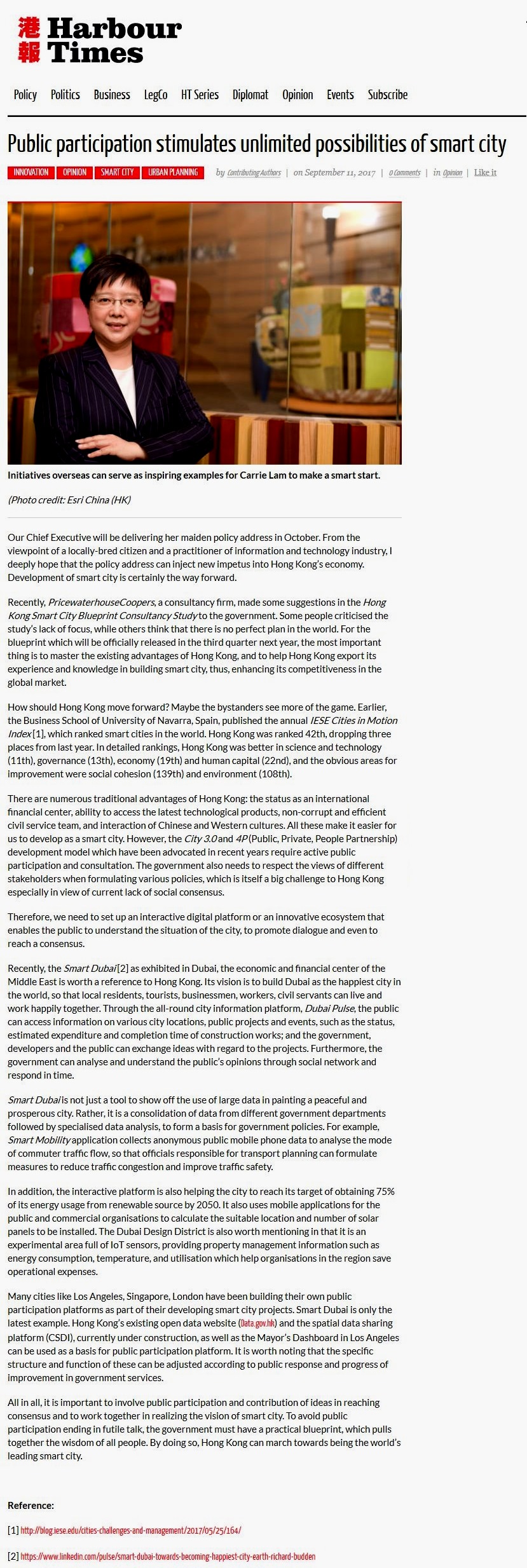網上版請按此

Public participation stimulates unlimited possibilities of smart city
Our Chief Executive will be delivering her maiden policy address in October. From the viewpoint of a locally-bred citizen and a practitioner of information and technology industry, I deeply hope that the policy address can inject new impetus into Hong Kong's economy. Development of smart city is certainly the way forward.
Recently, PricewaterhouseCoopers, a consultancy firm, made some suggestions in the Hong Kong Smart City Blueprint Consultancy Study to the government. Some people criticised the study's lack of focus, while others think that there is no perfect plan in the world. For the blueprint which will be officially released in the third quarter next year, the most important thing is to master the existing advantages of Hong Kong, and to help Hong Kong export its experience and knowledge in building smart city, thus, enhancing its competitiveness in the global market.
How should Hong Kong move forward? Maybe the bystanders see more of the game. Earlier, the Business School of University of Navarra, Spain, published the annual IESE Cities in Motion Index [1], which ranked smart cities in the world. Hong Kong was ranked 42th, dropping three places from last year. In detailed rankings, Hong Kong was better in science and technology (11th), governance (13th), economy (19th) and human capital (22nd), and the obvious areas for improvement were social cohesion (139th) and environment (108th).
There are numerous traditional advantages of Hong Kong: the status as an international financial center, ability to access the latest technological products, non-corrupt and efficient civil service team, and interaction of Chinese and Western cultures. All these make it easier for us to develop as a smart city. However, the City 3.0 and 4P (Public, Private, People Partnership) development model which have been advocated in recent years require active public participation and consultation. The government also needs to respect the views of different stakeholders when formulating various policies, which is itself a big challenge to Hong Kong especially in view of current lack of social consensus.
Therefore, we need to set up an interactive digital platform or an innovative ecosystem that enables the public to understand the situation of the city, to promote dialogue and even to reach a consensus.
Recently, the Smart Dubai [2] as exhibited in Dubai, the economic and financial center of the Middle East is worth a reference to Hong Kong. Its vision is to build Dubai as the happiest city in the world, so that local residents, tourists, businessmen, workers, civil servants can live and work happily together. Through the all-round city information platform, Dubai Pulse, the public can access information on various city locations, public projects and events, such as the status, estimated expenditure and completion time of construction works; and the government, developers and the public can exchange ideas with regard to the projects. Furthermore, the government can analyse and understand the public's opinions through social network and respond in time.
Smart Dubai is not just a tool to show off the use of large data in painting a peaceful and prosperous city. Rather, it is a consolidation of data from different government departments followed by specialised data analysis, to form a basis for government policies. For example, Smart Mobility application collects anonymous public mobile phone data to analyse the mode of commuter traffic flow, so that officials responsible for transport planning can formulate measures to reduce traffic congestion and improve traffic safety.
In addition, the interactive platform is also helping the city to reach its target of obtaining 75% of its energy usage from renewable source by 2050. It also uses mobile applications for the public and commercial organisations to calculate the suitable location and number of solar panels to be installed. The Dubai Design District is also worth mentioning in that it is an experimental area full of IoT sensors, providing property management information such as energy consumption, temperature, and utilisation which help organisations in the region save operational expenses.
Many cities like Los Angeles, Singapore, London have been building their own public participation platforms as part of their developing smart city projects. Smart Dubai is only the latest example. Hong Kong's existing open data website (Data.gov.hk) and the spatial data sharing platform (CSDI), currently under construction, as well as the Mayor's Dashboard in Los Angeles can be used as a basis for public participation platform. It is worth noting that the specific structure and function of these can be adjusted according to public response and progress of improvement in government services.
All in all, it is important to involve public participation and contribution of ideas in reaching consensus and to work together in realizing the vision of smart city. To avoid public participation ending in futile talk, the government must have a practical blueprint, which pulls together the wisdom of all people. By doing so, Hong Kong can march towards being the world's leading smart city.
Dr. Winnie Tang
Honorary Professor, Department of Computer Science, The University of Hong Kong